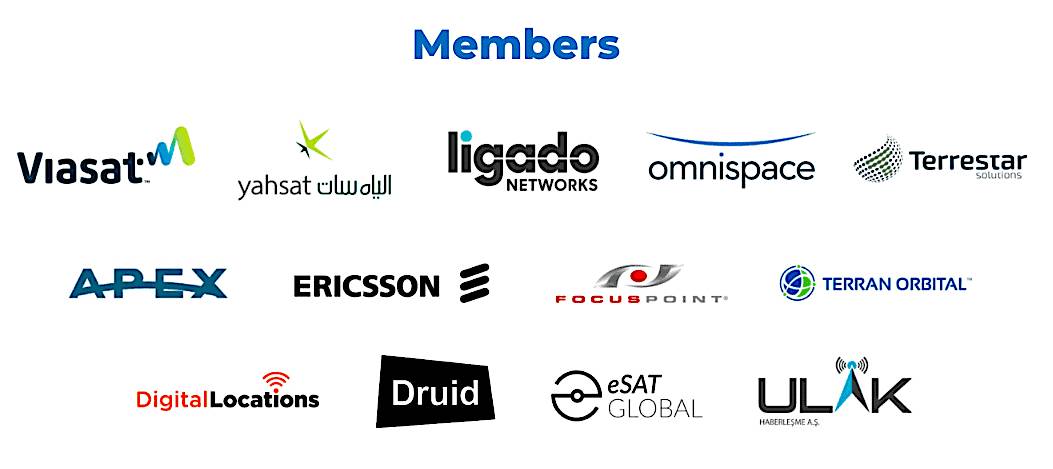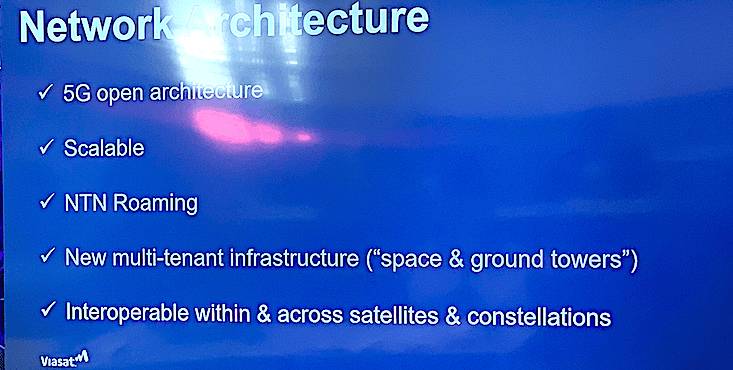Originally published by Space Intel Report on October 23, 2024. Read the original article here.
 (Source: MSSA)
(Source: MSSA)
MOUNTAIN VIEW, Calif. — Satellite direct-to-device (D2D) service will succeed globally only if its providers can assure governments that they’ll retain sovereign control of their national telecom infrastructure, and if mobile satellite services providers make their networks compatible not just with 3GPP standards but also with each other’s satellites.
This is the thesis behind the Mobile Satellite Services Association (MSSA), created earlier this year by Viasat; mobile satellite service provider Thuraya owner Yahsat (now Space42); Ligado; Omnispace and Terrestar.
Viasat Chairman Mark Dankberg has been named chairman of MSSA. In an Oct. 22 speech here at Silicon Valley Space Week, organized by Satnews Events,
Dankerg said regulatory acceptance and mobile satellite service provider interoperability are indispensable for D2D’s growth.
MSSA’s membership does not include AST SpaceMobile or SpaceX Starlink, both building satellite infrastructure that uses terrestrial spectrum in a revenue-sharing agreement with mobile network operators (MNOs).
MSSA was founded by companies with S- and L-band spectrum licenses that are globally authorized to operate. These companies do not believe that the Starlink and AST SpaceMobile business models will find traction worldwide because many MNOs will not want to share their spectrum, and because this model will force D2D players to carve out large buffer zones at the perimeter of their operations to avoid interference with neighboring MNOs’ operations.
 (Source: Silicon Valley Space Week video)
(Source: Silicon Valley Space Week video)
“There is confusion around this,” Dankberg said. “It’s not clear that individual mobile network operators want to take their spectrum out of play to create this value proposition. We think [the D2D opportunity] is very big. But terrestrial mobile markets have hundreds of billions of annual run rate. And their low- and midband spectrum is not orders of magnitude greater than spectrum available to mobile satellite operators on a global basis.
“We don’t think it’s a good solution to make terrestrial operators take spectrum out of play to apply it to satellite. The yield on that would be quite a bit less.
“Why not just make this available as a service just like any other roaming service, to make it attractive for the end users and the MNOs? That is the business model we are looking at. The idea tis that this augments their service.”
MSSA also does not count veteran mobile satellite service providers Iridium and Globalstar. EchoStar, which has a global S-band license but has not yet built its network, is absent as well.
Asked whether securing Iridium and Globalstar membership would give MSSA a boost in credibility, Dankberg said: “Nope. But we’d like to have them, don’t get me wrong…. This is an open, standards-based, open-architecture system.”
Viasat’s Ku- and Ka-band broadband businesses has resisted standards-based terminals for years. The MSSA membership is a result of Viasat’s purchase of mobile satellite operator Inmarsat in May 2023.
 (Source: MSSA/Viasat)
(Source: MSSA/Viasat)
Dankberg said the mobile satellite service industry is faced with the same question posed to MNOs years ago: Remain stovepipe with your own network or open it up to competing providers to allow seamless roaming for customers, and to share the cost of cell towers.
Dankberg said mobile satellite providers are fiercely competitive, but that the D2D potential is so large that they’ll need to cooperate to seize it.
It’s “something that’s never happened in the mobile satellite industry before, with interoperability across all these different networks and their satellite and ground infrastructure, which has great potential to reduce cost, make these services far more efficient and attract capital,” he said.
He did not detail how revenue would be shared among satellite operators with spectrum in the same geography that agree to pool their resources in an MSSA-type business model. But he said this is indispensable to maximize the use of available L- and S-band resources and assure delivery of a service that will win customer support.
“Now, if you have a mobile satellite terminal it works only with the operator you bought it from,” Dankberg said. “So Inmarsat doesn’t work with Iridium, which doesn’t work with Thuraya, which doesn’t work with Globalstar. The idea here is: We create roaming — seamless and passive from the end users perspective — so they can get service no mater which satellite they are using.”
He said L-band satellite operators have a long history of coming into a given market with only a fraction of their licensed spectrum, “because they have this a priori obligation to avoid interfering with other license holders.”
 (Source: MSSA/Viasat)
(Source: MSSA/Viasat)
Regulatory access may be the biggest challenge facing D2D, Dankberg said.
“One of the biggest issues that MSSA is aiming to deal with pretty directly is the issue of national security and national sovereignty,” Dankberg said. “The concept that anybody in any country with a mobile device could completely circumvent all the national telecommunication laws that that country has” will be a showstopper for regulators. “For this to be welcomed and adopted in a number of countries around the world, we see addressing this as an important element.”
The ‘wake-up call’ from X, Starlink and Brazil
Dankberg said the recent confrontation between Starlink and the Brazilian government illustrates the kind of issues that D2D could face unless it gives governments confidence that they remain in control of communications on their territories.
Brazil wanted to stop the use of X, the former Twitter, after concluding that it violated their laws. The government decided to deny X access by saying Brazilian telecom networks could not provide access to X.
Starlink said it can continue carrying X — which like Starlink is owned by Elon Musk — and did not need Brazilian telcos’ cooperation. The government then decided to shut down Starlink access. The two sides ultimately came to an agreement.
“That is a wake-up call,” Dankberg said of the Starling-Brazil conflict. “That compromises the integrity of essential all telecom applications.”
“If people can essentially get outside your national telecom infrastructure and policy, this is something that a lot of countries have not yet reckoned with. We think it’s coming and will be one of the factors in the adoption of NTN networks on a global basis.
“It’s not just a question of being compliant, It’s a question of giving countries confidence that they can ensure that compliance.
“That is one of the things we have taken to heart in the MSSA. We are now building a network architecture to support it. Some of that may involve physical control of satellites or constellations, or other mechanisms, depending on the countries. We think all those things are doable if you architect the networks correctly.
“That is one of the things that will make this really attractive in large areas of the world — extending the national control of infrastructure. Those of you involved in in-flight connectivity know that this is one of the constraints of being able to deliver IFC in certain air spaces or at certain airports. This has become a very big focus in the NTN space.”
Originally published by Space Intel Report on October 23, 2024. Read the original article here.
